Training Your Other Sawing Arm
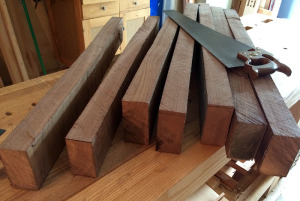 I’m a lefty and proud of it, but I have had to train my dumb right hand to do things over the years. At first it was planing because every vintage moulding plane I bought was meant for right handed use. Then it was chisel work as I discovered while carving I would have to switch hands constantly or be forever un-clamping and shifting my work piece then clamping again. Then it was turning as one leg would get tired and I would need to switch feet and change my body position at the treadle lathe thus necessitating I switch my grip on the gouge or skew. Gradually my dumb hand has become a little smarter.
I’m a lefty and proud of it, but I have had to train my dumb right hand to do things over the years. At first it was planing because every vintage moulding plane I bought was meant for right handed use. Then it was chisel work as I discovered while carving I would have to switch hands constantly or be forever un-clamping and shifting my work piece then clamping again. Then it was turning as one leg would get tired and I would need to switch feet and change my body position at the treadle lathe thus necessitating I switch my grip on the gouge or skew. Gradually my dumb hand has become a little smarter.
This was running through my mind as I stopped sawing to let my left arm rest this weekend. I was breaking down rough sawn 12/4 Walnut for the dining table I’m building. I actually really enjoy ripping with a hand saw, it is soothing work. I also love that it is a great work out to boot, but my arm does get tired and it bothers me that 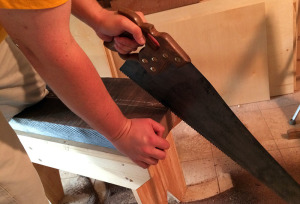 I have to stop working completely to give my arm a rest when I have a whole other arm that could be sharing in the work load. But every time I have tried to use that arm it has been a disaster. It needs training but I have yet to set aside time to just make practice cuts using only my right arm and when I’m working on a project I can’t really afford all the clean up time that comes from an errant saw cut. I also find that the awkwardness of my right arm translates to really slow sawing as no doubt that is the weaker arm.
I have to stop working completely to give my arm a rest when I have a whole other arm that could be sharing in the work load. But every time I have tried to use that arm it has been a disaster. It needs training but I have yet to set aside time to just make practice cuts using only my right arm and when I’m working on a project I can’t really afford all the clean up time that comes from an errant saw cut. I also find that the awkwardness of my right arm translates to really slow sawing as no doubt that is the weaker arm.
So I got to thinking about how I trained my right hand to do the above things and always they were 2 handed operations where my “smart” hand can help guide the dumb one. This greatly aided during those initial awkward attempts at using my off hand until my right hand could work on its own. Two handed sawing is always a possibility and I even have a nice rip saw with a thumbhole handle. However I always find that two handed sawing throws off my cut substantially and I end up sawing out of plumb because of the way my body mechanics change when I engage my second hand. So I couldn’t rely on the guiding hand technique like I had done for every other retraining attempt.
Then if occurred to me that I already had a guiding element in the form of the saw itself. A well tuned saw wants to saw straight and plumb. All I had to do was get the kerf established in the right plane and it should guide my hand. In fact I might even end up with a better cut since usually the more I can get out of the way of the saw and let it do its job, the better the saw cuts.
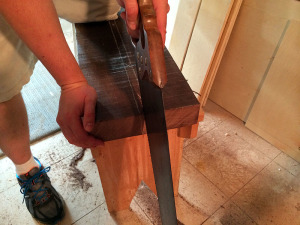 So I started the cut with my left hand tracking down the end grain and then into the board’s length about a full saw plate width. This arm has hours and hours of practice doing this and I was confident in my ability to set the kerf exactly where I wanted it.
So I started the cut with my left hand tracking down the end grain and then into the board’s length about a full saw plate width. This arm has hours and hours of practice doing this and I was confident in my ability to set the kerf exactly where I wanted it.
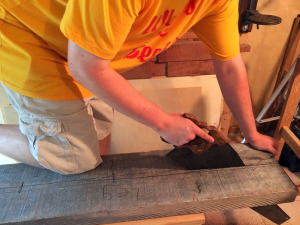 Then I switched hands and move to the other side of the sawbench and went to work with my right arm. Yes, it felt awkward and yet that arm is not as strong, but the already established kerf kept the saw on track and I was able to saw accurately albeit a bit slower while my left arm got a much needed rest.
Then I switched hands and move to the other side of the sawbench and went to work with my right arm. Yes, it felt awkward and yet that arm is not as strong, but the already established kerf kept the saw on track and I was able to saw accurately albeit a bit slower while my left arm got a much needed rest.
Now I could force myself to saw with my right arm without messing up the work and give it the much needed practice it would need to get stronger and more comfortable. I spent 3 hours sawing continuously yesterday blissfully listening to baseball on the radio and occasionally belting out a song. Every time I would flip the board (a practice I perform every 12″ during rip cuts to ensure even cuts) I would switch hands. And sure enough by the end of this time my right arm felt a lot more comfortable doing its work. So much so that on my last board I started the cut using my right arm and established a square and plumb kerf. It felt weird but it was accurate and that’s all I can ask. This further cements my belief that a lot of practice isn’t needed to improve your sawing, just concentrated practice over a short period of time and your body adapts and learns very quickly.
I have no doubt my right arm will be dumb again next time I try to saw with it, but hopefully it will remember faster next time around. And each subsequent time it will remember faster and faster and grow stronger and stronger to the point where both arms are pulling their weight equally. At least I have a method to training it that woun’t end up with me planing out ridiculously out of square edges.
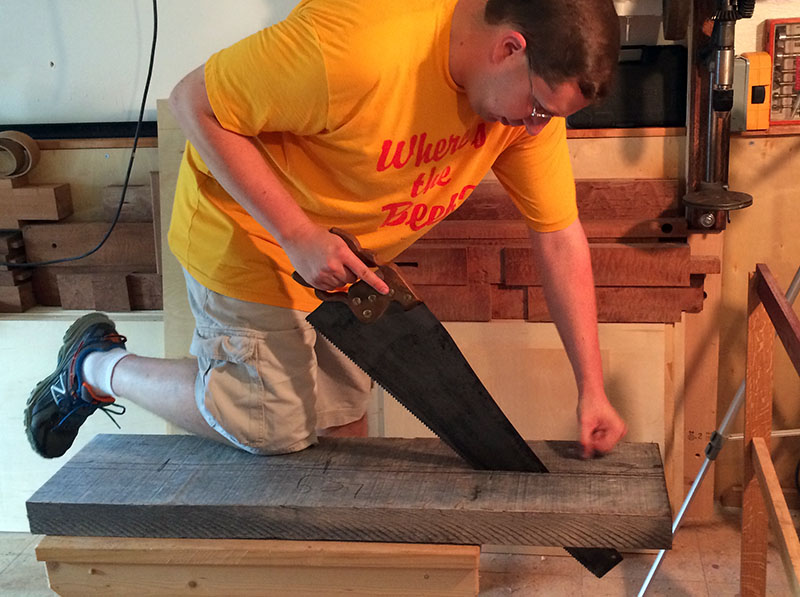
A well tuned saw will guide a cut, but good technique and body position still need to be observed. Pay attention to the swing of your arm and make sure it is unimpeded.
Your Turn
Are you ambidextrous in your woodworking? How did you get there and have any tricks to ease that first uncoordinated step?


